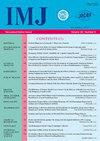初级保健和家庭医生实践中的多发性内分泌肿瘤
Q4 Medicine
引用次数: 0
摘要
多发性内分泌肿瘤的特点是易发生涉及两个或多个内分泌腺的肿瘤。该疾病的四种主要形式是作为常染色体显性综合征遗传的,或者可能偶尔发生。除了这四种形式外,还有六种其他综合征与多种内分泌和其他器官肿瘤的存在有关:甲状旁腺功能亢进症(颌骨肿瘤)、卡尼综合征、冯-希佩尔-林道病、1型神经纤维瘤病、Cowden综合征和McCune-Albright综合征。人类多发性内分泌肿瘤综合征的诊断可以通过三个可用标准之一来确定:临床特征、家族史、基因分析。这些综合征期间的突变分析在临床实践中有助于确认临床诊断;识别耐受突变且需要筛查的家庭成员,以及识别不耐受突变的家庭成员。多发性内分泌肿瘤综合征(Wermer综合征)的特征是存在三种肿瘤,包括甲状旁腺肿瘤、嗜铬细胞瘤和甲状旁腺肿瘤。它与先天性巨结肠合并发生的频率较低,先天性巨肠病是由肠末端缺乏营养神经节细胞引起的,会导致结肠肿大、严重便秘和梗阻。该综合征可能与皮肤淀粉样地衣变性有关,临床表现为瘙痒和地衣样病变,通常位于上背部。介绍一例52岁的MEN2综合征患者的临床病例。值得注意的是,对于这类患者,除了及时对这种内分泌多病理进行综合征而非成分诊断外,癌症髓样甲状腺癌的肿瘤过程向其包膜和周围组织的扩散以及外周淋巴结转移的存在也很重要。一般来说,这类病人不能及时治愈。关键词:多发性内分泌肿瘤,内分泌肿瘤,遗传分析,家族史。本文章由计算机程序翻译,如有差异,请以英文原文为准。
MULTIPLE ENDOCRINE NEOPLASIA IN PRACTICE OF PRIMARY CARE AND FAMILY PHYISICIANS
Multiple endocrine neoplasia is characterized with a predisposition to tumors involving two or more endocrine glands. The four main forms of the disease are inherited as an autosomal dominant syndrome or may occur sporadically. In addition to these four forms, six other syndromes are associated with the presence of multiple endocrine and other neoplasms of the organs: hyperparathyroidism − jaw tumors, Carney complex, von Hippel−Lindau disease, neurofibromatosis type 1, Cowden syndrome and McCune − Albright syndrome. The diagnosis of multiple endocrine neoplasia syndrome can be established in humans by one of the three available criteria: clinical features, family history, genetic analysis. Mutation analysis during these syndromes is useful in clinical practice to confirm the clinical diagnosis; identifying family members who tolerate the mutation and need to be screened, and identifying family members who do not tolerate the mutation. Syndrome of multiple endocrine neoplasia (Wermer syndrome) is characterized by the presence of a triad of tumors, including tumors of the parathyroid glands, pheochromocytoma and tumors of the parathyroid gland. It occurs less frequently in combination with Hirschsprung's disease, caused by the absence of vegetative ganglion cells in the intestine terminal parts, that leads to colonic enlargement, severe constipation and obstruction. This syndrome may be associated with cutaneous lichen amyloidosis, the clinical manifestations of which are pruritus and lichenoid lesions, usually located in the upper back. A clinical case of MEN2 syndrome in a 52−year−old patient is presented. It is noted that for such patients, in addition to timely syndromic rather than component diagnosis of this endocrine multipathology, the spread of neoplastic process in medullary thyroid cancer to its capsule and surrounding tissues, as well as the presence of metastases in peripheral lymph nodes are important. As a rule, such patients cannot be timely cured.
Key words: multiple endocrine neoplasia, endocrine tumors, genetic analysis, family history.
求助全文
通过发布文献求助,成功后即可免费获取论文全文。
去求助
来源期刊

International Medical Journal
医学-医学:内科
自引率
0.00%
发文量
21
审稿时长
4-8 weeks
期刊介绍:
The International Medical Journal is intended to provide a multidisciplinary forum for the exchange of ideas and information among professionals concerned with medicine and related disciplines in the world. It is recognized that many other disciplines have an important contribution to make in furthering knowledge of the physical life and mental life and the Editors welcome relevant contributions from them.
The Editors and Publishers wish to encourage a dialogue among the experts from different countries whose diverse cultures afford interesting and challenging alternatives to existing theories and practices. Priority will therefore be given to articles which are oriented to an international perspective. The journal will publish reviews of high quality on contemporary issues, significant clinical studies, and conceptual contributions, as well as serve in the rapid dissemination of important and relevant research findings.
The International Medical Journal (IMJ) was first established in 1994.
 求助内容:
求助内容: 应助结果提醒方式:
应助结果提醒方式:


